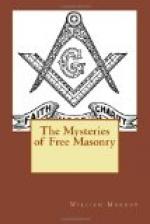Q. What did they do with the body? A. They carried it out at the West gate of the Temple, and buried it till low twelve at night, when they three met agreeably to appointment, and carried it a westerly course from the Temple, and buried it under the brow of a hill, in a grave six feet, due East and West, six feet perpendicular, and made their escape.
Q. What time was he slain? A. At high twelve at noon, when the crafts were from labor to refreshment.
Q. How came he to be alone at that time? A. Because it was the usual custom of our Grand Master, Hiram Abiff, every day at high twelve, when the crafts were from labor to refreshment, to enter into the sanctum sanctorum, or holy of holies, and offer up his adorations to the ever-living God, and draw out his plans and designs on his Tressle-Board, for the crafts to pursue their labor.
Q. At what time was he missing? A. At low six in the morning, when King Solomon came up to the Temple, as usual, to view the work, and found the crafts all in confusion; and, on inquiring the cause, he was informed that their Grand Master, Hiram Abiff, was missing, and no plans or designs were laid down on the Tressle-Board for the crafts to pursue their labor.
Q. What observations did King Solomon make at that time? A. He observed that our Grand Master, Hiram Abiff, had always been very punctual in attending, and feared that he was indisposed, and ordered search to be made in and about the Temple, to see if he could be found.
Q. Search being made, and he not found, what further remarks did King Solomon make? A. He observed he feared some fatal accident had befallen our Grand Master, Hiram Abiff; that morning twelve Fellow Crafts, clothed in white gloves and aprons, in token of their innocence, had confessed that they twelve with three others, had conspired to extort the Master Mason’s word from their Grand Master, Hiram Abiff, or take his life; that they twelve had recanted, but feared the other three had been base enough to carry their atrocious designs into execution.
Q. What followed? A. King Solomon ordered the roll of workmen to be called, to see if there were any missing.
Q. The roll being called, were there any missing? A. There were three, viz., Jubela, Jubelo, and Jubelum.
Q. Were the ruffians ever found? A. They were.
Q. How? A. By the wisdom of King Solomon, who ordered twelve Fellow Crafts to be selected from the bands of the workmen, clothed in white gloves and aprons, in token of their innocence, and sent three East, three West, three North, and three South, in search of the ruffians, and, if found, to bring them forward.
Q. What success? A. The three that traveled a westerly course from the Temple, coming near the coast of Joppa, were informed by a wayfaring man, that three men had been seen that way that morning, who, from their appearance and dress, were workmen from the Temple, inquiring for a passage to Ethiopia, but were unable to obtain one, in consequence of an embargo which had recently been laid on all the shipping, and had turned back into the country.




